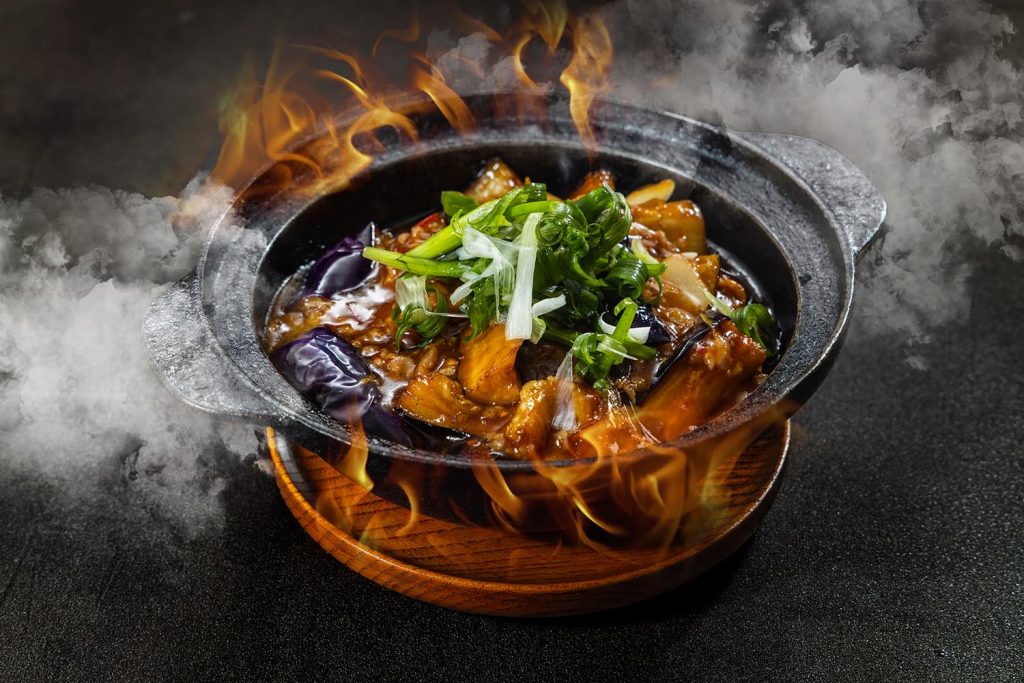今回の写真【充滿著蒸汽與火焰的中式香氣鑊氣小炒, 大排檔煲仔菜魚香茄子鍋】についてですが、主な加工はお客様のご要望に応じて行ったものです
元の写真はシンプルな黒い石目調の背景だけで、煙や炎の演出はありませんでした。通常、煙や炎を撮影に取り入れるには、照明の設定を非常に細かく調整する必要があります。フラッシュの光は炎よりも強すぎるため、使用すると炎が目立たなくなります。しかし、フラッシュを使わないと料理の細部が鮮明に写らず、色調も保ちにくくなります。炎を際立たせようとすると、料理が暗くなり、元の鮮やかな色味が失われてしまいます。
そのため、結論としては、煙や炎の演出は後加工で加えるのが一般的です
今回の写真も、クライアントから「熱々の土鍋料理」の雰囲気を求められたため、後加工で炎や煙を加えることで、画面をより豊かにし、効果もコントロールしやすく、撮影時間の節約にもなりました。
後加工をしやすくするためのちょっとしたコツとしては、なるべく暗めの背景を使うことです。そうすることで、炎の演出がより際立ち、見た目もスタイリッシュになります。今回の写真も、後加工でデザインに組み込む際には、簡単なテキストを加えるだけで、十分に素材として活用できる仕上がりになっています。
「鑊氣(ウォック・ヒー)」とは、広東料理における重要な概念で、強火で炒めることで食材に香ばしさと深い風味を与える技術です
香港の屋台文化で発展し、料理人の火加減と手際が味の決め手となります。この一枚は、蒸気と炎が舞う中華の香りに包まれた瞬間を捉えたものです。熱々の鍋から立ち上る香ばしい匂い、鉄鍋で豪快に炒められる料理、そして魚香茄子の濃厚な香りが漂う鍋、まさに五感を刺激する一皿一皿の物語を、レンズ越しに記録しました。
煲仔菜は広東省発祥で、特に香港の冬に人気のある料理です。土鍋で米や具材を炊き上げることで、香ばしい「おこげ」ができ、旨味が凝縮されます。代表的な料理には「臘味飯」や「牛肉煲」などがあります。
また、「魚香(ユーシャン)」は四川料理の伝統的な味付けで、元々は魚料理に使われていた調味法です。唐辛子、ニンニク、生姜、酢、砂糖などを使った甘辛い味が特徴で、ナスとの相性が抜群です。香港では煲仔風にアレンジされることもあります。
The photo titled “Aromatic Wok-Fried Stir-Fry with Steam and Flames – Street-Style Claypot Dish Featuring Yu-Shiang Eggplant” was primarily edited according to the client’s request.
The original image featured a simple black stone-textured background, without any visual elements like steam or flames. Capturing such effects during a shoot requires meticulous lighting adjustments. Flash lighting tends to overpower the flames, making them barely visible. On the other hand, avoiding flash can result in a lack of clarity and diminished color vibrancy in the dish. If the flames are emphasized, the food itself may appear too dark, losing its original vivid tones.

Therefore, it’s common practice to add steam and flame effects during post-production.
In this case, the client wanted to evoke the feeling of a sizzling hot claypot dish. By adding flames and steam in post-editing, we enriched the visual narrative, gained better control over the final look, and significantly reduced shooting time.
A helpful tip for post-production is to use a darker background. This enhances the visibility of flame effects and gives the image a more stylish finish. For this photo, the final composition works well even with minimal text overlay, making it a versatile design asset.
The concept of “wok hei” is central to Cantonese cuisine—it refers to the smoky aroma and deep flavor imparted by high-heat stir-frying. This technique, developed through Hong Kong’s street food culture, relies heavily on the chef’s control of heat and timing. This image captures the essence of that moment: the rising steam, the dancing flames, the sizzling iron wok, and the rich aroma of yu-shiang eggplant—all coming together to tell a sensory story through the lens.
Claypot dishes originated in Guangdong and are especially popular during Hong Kong’s winter months. Cooking rice and ingredients in a claypot creates a crispy layer at the bottom, concentrating the flavors. Signature dishes include Lap Mei Fan (preserved meat rice) and Beef Claypot.
Meanwhile, Yu-Shiang (literally “fish fragrance”) is a traditional seasoning method from Sichuan cuisine, originally used for fish. It features a sweet and spicy blend of chili, garlic, ginger, vinegar, and sugar—an ideal match for eggplant. In Hong Kong, this flavor profile is often adapted into claypot-style dishes.

